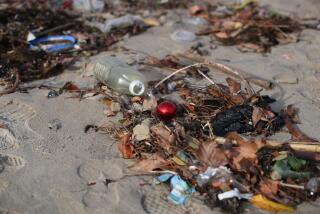Fun’s in the Family
Arms hugging a large shallow box, Briana Moya, 4, shakes a dozen clear marbles in a pool of paint and watches, wide-eyed, as they become Technicolor.
She looks up at her mother, Ginna Moya, smiling. Ginna smiles back.
In minutes, Briana and her mother are off to another craft in a room buzzing with the talk of happy children and their parents. There are cereal necklaces to be strung, gingham beanbags to be tossed, Play-Doh cookies to be cut and bowling pins--made from plastic pop bottles--to be toppled.
Welcome to the world of child-abuse prevention.
During the summer, a monthly Family Fun Night is sponsored for parents and their young children at the South County Family Resource Center in the Mission Viejo Mall. The facility opened last fall under the sponsorship of four Orange County agencies: the Child Abuse Prevention Council, the Children’s Bureau, Community Services Programs and Mission Hospital. Most of the activities are free or cost $5 per family.
Like most parents who visit the center, Moya is there to continue fostering a wholesome relationship with her child. “I’m a single mom, work full time at a very fast-paced job, and this gives me a chance to relax with Briana,” says Moya of Lake Forest. “It takes a lot of responsibility to be a single parent.”
The long, hot summer months can be tough on parent-child relationships. Kids get bored. Parents get irritable. And before they know it, heated words can be exchanged. Or a slap or two.
In a county where last year more than 34,675 incidents of abuse or neglect were reported, activities such as those provided by the center are invaluable, says Barbara Oliver, executive director of the Child Abuse Prevention Council in Tustin.
The resource center “provides a place where parents can learn to parent, find out about services available to them and interact in positive ways with their children,” Oliver says. “Our goal is to help establish family resource centers all over the county.”
Summer is a difficult time for parents and school-age children, says parent educator Ann Corwin of Laguna Niguel, because there has been a “shift in their dynamics.”
“They have gone from the regular school year, where there’s been a lot of separateness, to a kind of forced togetherness. Parents may be frustrated because they have to continue to work. And kids don’t have school activities,” she says.
The answer, Corwin says, is to make sure any frustration being felt by a parent or child isn’t turned into abuse. “Just because kids are feeling displaced doesn’t mean it’s their fault. And parents shouldn’t be feeling guilty that they can’t always be there. The key is to get everybody as involved as possible in activities that are appropriate to a child’s age.”
Parents can set up opportunities for interactive play with their children.
“There could be one night where the family plays cards,” says Corwin, who teaches a class called Powerful Practical Parenting at the resource center. “And a day when everyone goes to the pool or the beach. The idea is to set up time that reinforces the togetherness that summer dictates.
“When you welcome the change, recognize it, then you can work with it. It’s almost a conscious, cognitive shift, where you say, ‘Oh! It is changing. How can I welcome that change? How do we survive?’ ”
To survive the frustration of the summer months, a parent must plan, Corwin says. “Set an agenda. Kids survive in school because there’s an agenda. Give your children instructions to help around the house on a Tuesday, for example. And tell them Wednesdays are for movies. Boundaries help them function better.”
*
Most child abuse occurs when a parent expects behavior that is beyond a child’s ability. “The No. 1 thing parents need to learn is what’s normal behavior for whatever stage of development their child is in,” Oliver says.
Take the crying of a small baby. A parent shakes the baby to teach it not to cry. “What would bring a parent to do that?” Oliver asks. “They are basing their behavior on the myth that the baby is crying to manipulate the parent.
“That baby isn’t old enough to have learned to do that. But if you don’t understand that, you’re frustrated. And if you don’t have good coping skills, it wouldn’t be too much of a leap to think you could get to shaking a child.”
Corwin’s classes aim to help parents understand what is normal development for children so they respond appropriately to a child’s behavior, she says.
“A baby doesn’t cry to get a parent’s goat. A baby cries to stimulate another person’s proximity to them. Their cry is the only way to get close so their needs can be met.”
Corwin helps parents examine their behavior. “We try to get parents to look in the mirror a little bit. If their behavior changes, the behavior of those around them will change. We work with them to recognize that they are a model for their child, and if they learn to control themselves, then their children will learn control.
“That’s the most powerful tool we have to change behavior.”
For resource center information: (714) 364-0500.
More to Read
Sign up for Essential California
The most important California stories and recommendations in your inbox every morning.
You may occasionally receive promotional content from the Los Angeles Times.










